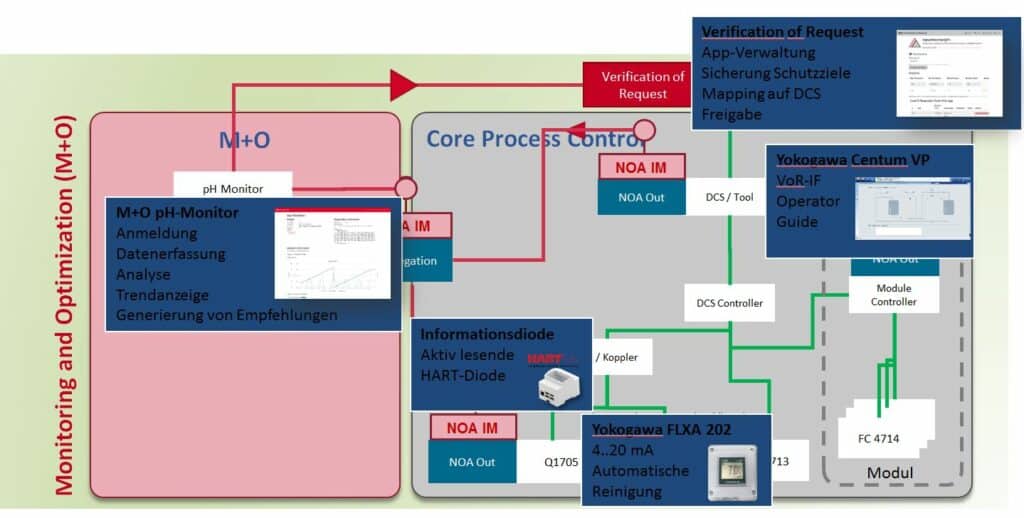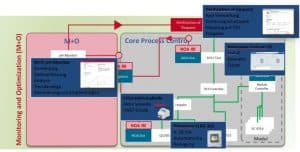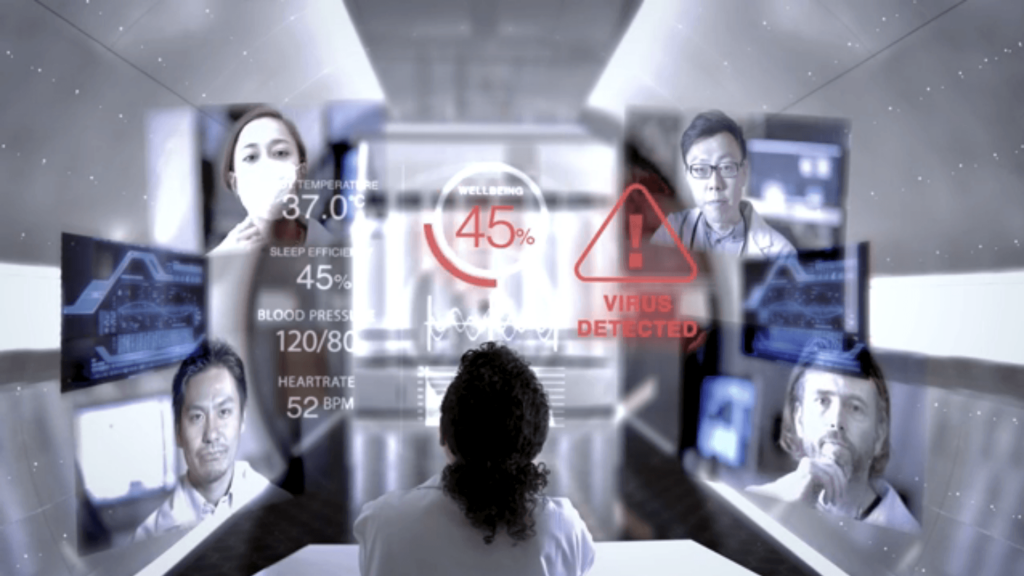When it comes to NOA, the discussion often centers on the departure from the classic automation pyramid with all of the ensuing consequences, especially with regard to (data) security. There’s no question of security being compromised. A lot of initiatives have been launched here. I’d like to show you why all of these efforts are worth it. I’ll be using the PAT demonstrator unveiled at the NAMUR Annual General Meeting 2018 as an example.
PAT demonstrator: All it wants to do is communicate
Various NOA demonstrators were featured in a workshop at the NAMUR Annual General Meeting 2018. Only one of them was concerned with process analytical technology. It was presented by Professor Leon Urbas (Professor of Process Control Systems at TU Dresden) and developed in cooperation with the University’s Process Systems Engineering Group, Yokogawa Germany and the owners of the IGR interest group’s NOA demonstrator at Industriepark Hoechst.
The analytical heart is an analog pH sensor. A combination electrode just like tens of thousands of others in our brownfield plants. The sensor is installed in a retractable assembly which allows it to be removed from the process at regular intervals and treated with cleaning solution. The measured values and any alarms or warnings are processed in the control system, which also controls the cleaning device.
The value of the measuring equipment …
The value of the analytical measuring equipment is clear: the pH generally serves to monitor the process or to navigate through it as it runs – a kind of GPS guide to the process! If you’ve ever lost your way – whether driving your car or navigating through an industrial process – you’ll know exactly what I mean.
… and the buried treasure adds even more value
The sensor carries on measuring during the cleaning phase. The values it measures are not without interest. If a cleaning solution with a defined pH is used, then we have a setpoint. If the sensor reaches this setpoint, this is a sign that it’s working correctly. If the setpoint isn’t reached, the sensor is probably drifting (calibrate it!); it could also be dirty or even about to give up the ghost completely. There’s another interesting phase when the sensor is exposed to the medium again. The sensor indicates a transient curve to the measured value. If it takes longer to settle, that’s also a clue to fouling, for instance on the reference electrode. Even without a cleaning device, signals can still be evaluated, such as the impedance of the reference electrode.
All of this is highly relevant information about the sensor’s state (of health). And best of all, this information is already there. Without you having to actively collect it – it simply appears during the cleaning phase. Like a free, more or less continuous medical checkup. And the operator isn’t even aware! The only pointer during the cleaning phase is that the sensor is on hold.
Potential treasure-diggers
Interesting diagnostic data is supplied in this way at short intervals. Yet the sensor doesn’t have much of a brain. It’s purely analog. If it wants to share any knowledge with you, it does it the easy way in HART. There are some signals where every single bit of information literally has to be wormed out of it.
So who should it share that information with? The control system? The control system would have to record data while the sensor was on hold. It would need to compare values with a setpoint at the end of the cleaning phase in order to determine the settling time. And create a history for both values. But the control system’s far too busy for that! And, in any case, it hasn’t even got the capacity.
Well, what about the maintenance technician? He only notices when he carries out routine maintenance, in other words at very long intervals. That medical checkup will end up being more like a PAThological examination.
In fact, it’s actually all there already. The only thing that’s actually missing is someone who’ll listen to what the sensor has to say. The PAT demonstrator has a listener – let’s call him App.
App – the sensor’s audience
We’ll eavesdrop for a minute on what they’re saying and thinking.
App: Aha, a cleaning phase. In that case, I’ll take a look at the signals. That dude’s reached the setpoint – like a shot! I’ll see what the reference impedance is doing next – that’s OK as well. That dude’s in perfect health. Let’s get all of that entered in the patient’s record.
x cleaning cycles later
App: Watch out, here comes another cleaning phase. Aha, he didn’t quite reach the setpoint this time but he’s still within the tolerance – not quite as fast but fast enough. The reference impedance is getting close to the limit but it’s still alright. I’d better make a note of that – the “PAT doctor” could find it useful later on.
x cleaning cycles later
App: Cleaning phase, data analysis … oh dear, he didn’t reach the setpoint. The whole thing’s too slow and the reference impedance is too high. He’s in a poor state. Do you know what I’m going to do? I’m going to make an appointment for you with your doctor. The PAT doctor can pore over all of my diagnostic data later. Hello, is that the operator? My baby’s in a poor state. I’d urgently recommend (NOA recommendation for action!) sending a maintenance technician round to have a look at my sensor.
 How NOA adds value for the PAT
How NOA adds value for the PAT
- Data that is already there, but as yet invisible, is made both visible and usable
- Render unto the operator the things that are the operator’s – urgent action necessary
- Render unto the PAT specialist the things that are the PAT specialist’s
- Data to assist with commissioning
- Data to provide immediate support
- Data and history for the offline data analysis and optimization
- Trust in the sensor’s reliability increases owing to the quasi-continuous supply of data and the high level of availability and up-to-dateness – the PAT department can even see values while the sensor is “on hold”.
- There are fewer undetected errors
- The enormous flexibility makes it easier to adapt the system, or the app, to different applications
- Greenfield features become a reality for brownfield plants
Is this a special case?
No. It’s possible to generalize here. pH sensors with automatic cleaning are nothing unusual. For our purposes, though they’re only an example. PAT devices normally have far more signals than that which are capable of providing information on the reliability of measurement results or the condition of a device. The more complex devices become, the more information they can supply and the more predictive statements can be formulated regarding analysis reliability and maintenance needs. This buried treasure – value added – can be unearthed with NOA.
It’s not enough for technical systems simply to communicate
Efficient cooperation between the plant, the process control system and the PAT department is crucial to the success of these new opportunities. In the end, it’s all a question of communication. The PAT demonstrator has already proved that it works for process analytical technology on the technical level.


 How NOA adds value for the PAT
How NOA adds value for the PAT

